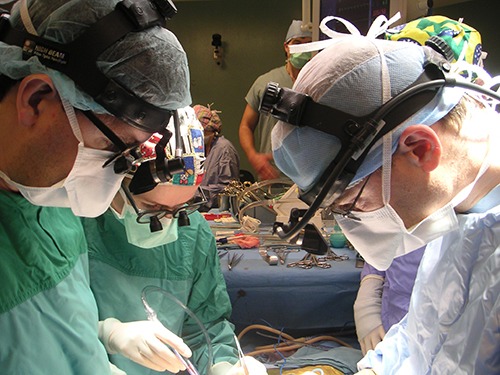UHN Newsroom

Thoracic surgeon Dr. Marc De Perrot, (R), has developed the world’s first pulmonary endarterectomy simulator in an effort to decrease the length of time it takes new surgeons to learn the technique, thereby broadening the pool of specialists who can offer the procedure. (Photo: UHN)
May 8, 2017
It resembles something out of a Tim Burton film: raw, red tree-like monsters with what look like angry, twisted branches. But rather than being the stuff of movie nightmares, it’s in fact scar tissue that has been carefully removed from inside the arteries of a patient’s lungs.
The scarring is the result of chronic thromboembolic pulmonary hypertension (CTEPH) when a mass caused by blood clots gets caught in the lungs’ blood vessels and blocks blood flow. The blood clots are caused by an acute pulmonary embolism (PE) – when a blood clot travels from one part of the body into the lungs and gets stuck.
Though a PE can be resolved with blood thinners, CTEPH can develop anywhere from a few months to decades after it occurs. While rare, CTEPH is also under-recognized since its symptoms – shortness of breath, dizziness, fatigue – are similar to other lung diseases and ailments.
Left untreated, individuals with CTEPH can die within three to five years. But a new world-first simulator, developed by Toronto Western Hospital thoracic surgeon Marc De Perrot in partnership with the National Research Council (NRC) and support from a Bayer HYPE innovation grant, is designed to teach a key treatment option for those with CTEPH to more surgeons.
More surgeons will be able to learn the procedure
The simulator will help teach pulmonary endarterectomy (PEA) surgery, which removes scar tissue from the pulmonary arteries in the lungs, to more surgeons, offering the potential of a huge improvement in the quality of life for patients such as Patrick Himmelheber, 37.
When Patrick couldn’t catch his breath during his first recreational hockey game of the season in the fall of 2015, he just thought he had let himself get out of shape over the summer.
“It was the beginning of the season and I got winded as soon as I got on the ice,” recalls Patrick. “I figured I really needed to work on my cardio, but it got to the point that I couldn’t play without getting short of breath and I quit the team.
“It was very weird to be so short of breath because I’m a pretty fit person and exercised regularly,” he continues. “But every time I exerted myself, even to go up the stairs, I couldn’t breathe.”



